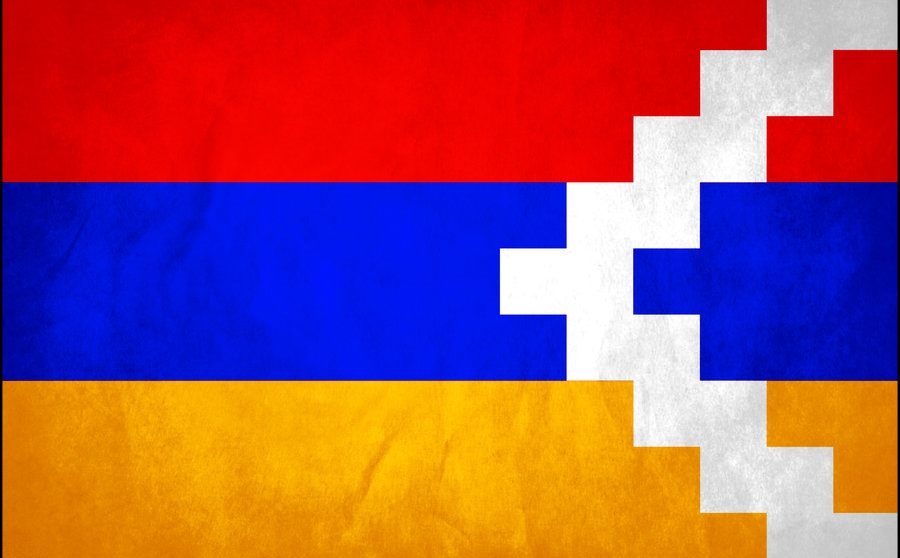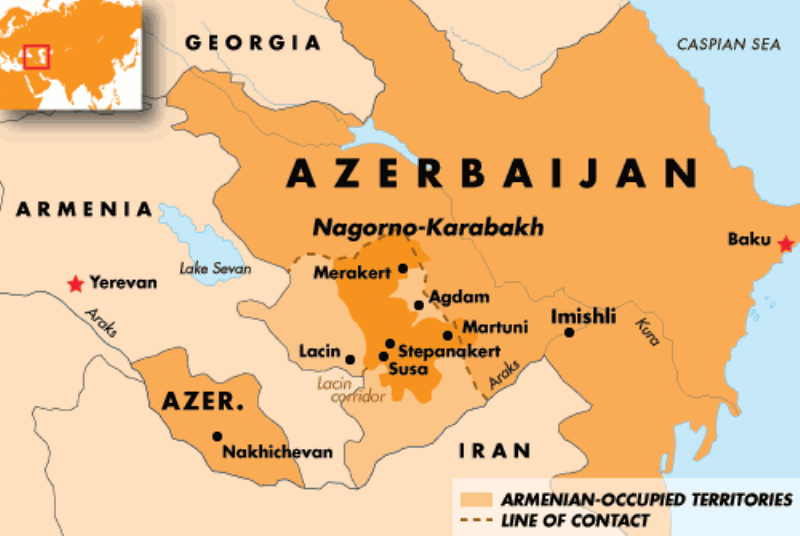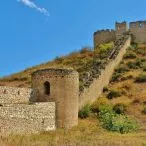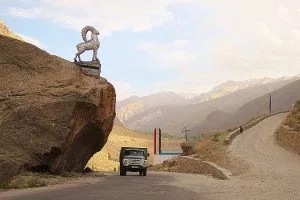Nagorno Karabakh

Official name: Nagorno-Karabakh Republic (Republic of Artsakh)
Population: 143 600
Area: 4 4000 km² (although under Armenian control there is about 14 000 km²)

Gallery
Introduction, tourist attractions of Nagorno Karabakh, Nagorno Karabakh – the present times, brief history of Nagorno Karabakh.
Introduction
In the beginning I want to stress that I include the Nagorno Karabakh Republic as an unrecognized territory and not as an independent country.
The Nagorno-Karabakh Republic is a very small and interesting country that formally does not even exist. Nagorno-Karabakh is a region which declared its independence and it is independent only in its own eyes and no one else’s. In addition Nagorno-Karabakh has its capital city called Stepanakert which is in reality just a main town and it also has a heavily exaggerated persons such as the president and the prime minister, despite the fact that the government of Armenia has the final word over Karabakh anyway. Officially Nagorno-Karabakh still belongs to the territory of Azerbaijan but it is occupied by Armenia. In 1920 Stalin proclaimed Nagorno-Karabakh as the autonomous region within Azerbaijan but in later years Karabakh asked for its independence by force with the help of Armenia and it has kept it to some extent since then. On the other hand due to the uniqueness of this small area and despite the fact that this self-proclaimed region keeps pretending a country I’ve decided to present Karabakh as a separate section on my website because I think that it is a travel story which should be told separately. Nagorno-Karabakh is also called “the Armenian culture within the territory of Azerbaijan”. What’s more interesting I even got a visa to a country which does not even exist.
Whilst in Karabakh I saw small towns destroyed by bombings carried out by Azerbaijan but also centuries-old churches, fortresses, mountain views and attractive nature. I spent five days in Upper Karabakh moving around mostly by hitchhiking what let me see a lot of interesting places. I noticed that the Karabakh people want tourists to visit their region so they could hear their story about the war with Azerbaijan and the struggle for their independence.
Tourist attractions of Nagorno Karabakh
Travelling around Nagorno-Karabakh is a hitchhiking adventure through far away mountain serpentines where at every stop awaits a good story. I stayed in the capital city of Stepanakert which is a very pleasant small town and where among many things I saw the museum of war with Azerbaijan, the museum of killed and missing soldiers and also the part dedicated to the Soviet propaganda in order to praise the Soviet Union as the conqueror of Hitler. The first museums were interesting and it is a topic that never ends because about the war with Azerbaijan would gladly tell us a truck driver, a meat salesman and a priest. The war subject in Karabakh simply does exist. I was under impression that the subject of glorification the Soviet Union is present in Karabakh but “without the ceremonial openings of champagne” and it is there as if someone was watching over it through the keyhole. I’m not going to defend Hitler but Stalin’s hands were just as dirty. The difference lies in the fact that the winner does not have to explain his crimes and a loser apologizes and pays for a very long time, even for the sins of others. Whilst in Stepanakert I saw a traditional bazaar, a tank on the pedestal and the statue that has become a symbol of Karabakh which is called Grandpa and Grandma.
I also liked the ruins of the town of Shushi situated 9km from Stepanakert. The town lies mostly in ruins after the bombings carried out by Azerbaijan but it comes to life and I think everyone should see it. I would also recommend a very interesting art gallery and the white Ghazenchetsots Cathedral, though I was mostly interested in the people living there and the ruins.
I also found the town of Agdam very interesting because it looked like a haunted place. After heavy bombardments carried out by Azerbaijan only a few houses remained and those that still stand are in terrible condition as they always miss walls or roofs. Agdam is on the line of fire with Azerbaijan and before the “town” I saw a military base of Armenia with a few big cannons and armoured vehicle. My feelings about Agdam are obviously tragic because about 20 years ago it was a normal city. People lived there, they went to work and children went to school. Today it is hard to imagine that there was a life there because today there are just ruins with a few standing walls. Either way Agdam was very special war experience which I highly recommend.

Gandzasar Church. Nagorno-Karabakh.
Apart from that Karabakh has a couple of interesting fortresses, such as the very attractive Mayraberd ruins and restored Tigranakert fortress. For such a small country Karabakh also has beautiful, ancient churches built in Armenian style, for example Gandzasar and Dadivank built in the fifth century. The Kharabak’s phenomenon of nature is the exceptional 2000 year old Skhtorashen tree which is empty inside and so huge that it could be converted into a studio flat. Besides, Karabakh is of course about hitchhiking trucks, stories about the war told by almost sober drivers, post-Soviet markets and the unforgettable atmosphere of the whole place.
Nagorno Karabakh – the present times
Economy
Economy of Nagorno-Karabakh is a small but it is rapidly expanding as evidenced by its GDP of the subsequent years. According to the data I could find in 1999 the GDP of Nagorno-Karabakh was only $59m, in 2005 it was already $114 and in 2009 it reached $260mln. Year by year gross domestic product (GDP) of this small country was significantly increasing. 57% of its GDP comes from the service sector, 16 % from agriculture, 9% from construction, and manufacturing stands at about 15 % of GDP. In previous years however the importance of agriculture had declined, while services and service production has increased.
Most investments are in telephone networks, gold mining, diamonds polishing and in jewelry. In Soviet times Nagorno-Karabakh had only one power plant and it relied on energy from Armenia, but now because of a multi-million dollar investment it will only stop importing but it will be also able to export. The main road from Goris to Stepanakert was built for $15m and whilst travelling around Nagorno-Karabakh I saw many good roads in good condition. The only holes in the roads were on the way to Dadivank monastery but I think it will change over time what will give employment to a lot of people and will be a subject of further investments. Karabakh has also Artsakh Bank and taking into account data from 2010 the number of loans and deposits have increased. A large branch of industry is also in mining, because Nagorno-Karabakh is rich in many metals such as gold and copper. Mining industry provides employment to more than 1,000 people and it is the largest tax payer in Nagorno-Karabakh. Karabakh is also a known exporter of mulberry vodka, watches, food and it is becoming more and more popular with tourists. The main beneficiaries of Karabakh are Armenia and the USA although their financial help is very small comparing to the needs.
Education
Education is compulsory and free for all until the end of secondary school and education has always been a priority for the Christian culture of Armenia. Due to the fact that most people in Karabakh are Armenian the educational program is also Armenian, while the system itself is modelled on the Russian system as it is considered very good and extensive. Obligatory education ends with the completion of a high school which is usually after the age of 18. Karabakh has also 9 universities although many people study in Armenia and Russia. The national university is named Artsakh.
It is also important that many schools and school equipment needs to be rebuilt because of bombings carried out by Azerbaijan. Rebuilding schools, sports facilities and equipment will cost minimum $25mln.
Health
Health system in Karabakh suffered a lot during the war with Azerbaijan and had to be completely rebuilt, and today it lacks basic sanitation and personnel. Despite there are about 19 hospitals in Karabakh there are mainly in Stepanakert what people living further means a difficult access to the health system. The total cost of rebuilding the health system, educating personnel and a cost of new equipment amounted to $15m.
Water is also of a bad quality and its access is limited because of destruction after the war. It is a whole system which installation will cost many million dollars.
I don’t have a statistical data from Karabakh about HIV/AIDS but comparing data from Armenia where there are about 3500 people living with the virus and taking into account a small population of Karabakh I suspect that HIV is brought to Karabakh mainly from Armenia and it is most common within drug users and faggots.
Culture/Religion
The culture of Nagorno Karabakh developed with the culture of Armenia and it is based on Christianity, what can be seen in ancient churches, cathedrals, chapels, frescoes and khachkars, which are crosses carved in stones. Today apart from the natural beauty of Karabakh old churches are the main tourist attractions of the country. Nagorno Karabakh also has its tradition of carpet making which is also closely related to the Christian art of Armenia.
I recommend my article about Armenia for additional information.
Media
It is difficult to say which place Karabakh would take when it comes to freedom of speech, because it is an unrecognized country. From what I know there is a strict censorship in Karabakh and there was even a case of a journalist who was sentenced for a year of prison for “defamation” of one politician. In my point of view Karabakh is a country of a limited freedom of speech and because of conflict with Azerbaijan press freedom stands lower than in Armenia.
Environmental issues
War with Azerbaijan has destroyed a lot of natural territories and rebuilding after the war resulted in road being built on environmentally beautiful places. Because of developing economy a lot of clean areas have been transformed into agricultural lands which in the times of war were occupied by the army. As hydropower energy keeps growing so is the water pollution which in Karabakh is already of a bad quality.

Brief history of Nagorno Karabakh
History of the Nagorno Karabakh Republic is very old and stormy as for such a small country, which announced its independence whilst being in the territory of Azerbaijan. I want add the history of Karabakh has an Armenian and Azeri version that’s why I will give only those facts which are definite. Especially when it comes to war over Nagorno Karabakh I heard many different stories from Azeris and Armenians.
Nagorno-Karabakh is determined by Azeris as their cultural centre and Sushi where they developed their literature and language. Azeris believe that Christian descendants of Karabakh originate from Albanians (without links to today’s country of Albania), and after the invasion of Arabs in the seventh century Karabakh that conflict. In the Middle Ages the region of Nagorno-Karabakh was under Persian control, where local powers were held by Armenian princes named Meliks. Despite that it was a flourishing time for Christian culture because in the thirteenth century were built the monasteries of Gandzasar and Dadivank. Then in 1805 the khanate of Karabakh came under the control of Russia because the Persian Empire lost its power and all its Caucasian territories were lost to Russia. Russia started to promote Christianity which led to the ethnic conflicts and that’s why during that time a lot of Muslims from Karabakh moved Persia, and many Christians from Persia moved to Karabakh.
Then, in 1920 Stalin declared Nagorno-Karabakh an autonomous region within Azerbaijan, and Nagorno-Karabakh was inhabited by the Armenian majority. In the 80’s there were strong movements supporting separation of Karabakh from Azerbaijan and creation of an independent state what resulted in a war between Karabakhi Armenians and Azerbaijanis and Soviet forces. It was the first war which was not so tragic comparing to the second one after the collapse of the USSR between Armenia and Azerbaijan and the Turkish helpers. Armenia won the war what cost lives of 30.000 people and in addition about 50 thousand Muslim Azerbaijanis living in Karabakh and another 150 thousand residing in Armenia must have returned to Azerbaijan. The armistice was signed in 1994 after death of 30 thousand people and it was such a huge shame for Azerbaijan that two successive governments collapsed until Heydar Aliyev finally came to power. Hundreds of thousands of Azerbaijanis had no roof over their heads and they had to live in tents or in bombed-out houses. I think that peace is something what should rather not expect; especially that Armenia still occupies territories of Azerbaijan even outside Karabakh located between Karabakh and Armenia. Nagorno-Karabakh also suffered heavily what can be seen in bombed cities.
Travel reports
Map

Location

Practical information
Tourist Visa: Nagorno-Karabakh can be reached only from Armenia. I got my visa at the consulate of Nagorno-Karabakh in Armenia in Yerevan for 3.000 dram; although I was told at the border that the Karabakh visa can be also developed in Stepanakert after entry. Karabakh is a country very open to tourism. Nagorno-Karabakh has very close relations with Armenia and most probably always will be.
Safety: Nagorno Karabakh is very safe. I travelled around the country mainly by hitchhiking and I met with people’s kindness every time.
Moving around the country: Transport by minibuses (marshrutkas) is very limited due to small population, that’s why hitchhiking is the best way of getting around Karabakh. Because of hitchhiking I saw a lot more than I planned and I think that for a lonely traveller it is the only option. Taxis are very expensive and that’s why I recommend them only to those travellers who travel around Karabakh in 4 or 5 people.
Prices: (in 2013 when £1= 650AMD). Nagorno Karabakh operates on Armenian dram. Prices in Karabakh are the same as in Armenia. For the cheapest room in Stepanakert I paid 5000 dram although I also recommend free lodging in your own tent. For food I spent about 2000 dram every day and for transport I did not spend a penny because I was hitchhiking everywhere.
Climate: Climate of Nagorno Karabakh is mild and mostly subtropical. During summers air temperatures varies from 22°C to 40°C, and during winters from -16°C to -23°C. Big valleys tend to have strong winds and storms and precipitation is small in the lowlands and high in the highlands, especially in May and June. In different parts of Nagorno Karabakh there is also a fog for about 110-125 days in a year.

















